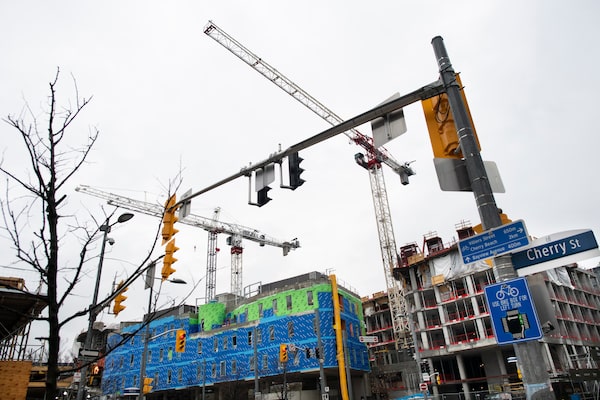
Construction cranes at a condominium development site on the north east corner of Cherry and Mill Sts. in Toronto, are photographed on April 5.Fred Lum/The Globe and Mail
Continued sluggishness in sales of new construction condominiums in Toronto is causing short-term pain for buyers and developers, but it could be renters who end up paying the price in the long term.
That’s because the largest source of new rental units in the Toronto region over the past 20 years have been condominium apartments that are leased on the secondary market by condo investors.
However the costs of acquiring and holding onto those unbuilt condos may have reached a point where investors are holding off on buying new condos, particularly if it seems likely future rents will not generate enough revenue – or that equity won’t rise quickly enough to flip – to earn a profit.
Urbanation Inc. reported that new condo sales in the GTA fell 68 per cent in the second half of 2022 on an annual basis, shifting just 5,419 units (an almost 20-year low). Even if those trends don’t continue that equates to potentially thousands of apartments taken out of the rental market in the coming years.
According to Pauline Lierman, vice-president of market research with Zonda Urban, the slowdown appears to be continuing in 2023. “This is the first quarter where we’ve had completions outrun starts,” as multiple developers are delaying new projects or new phases to see if demand picks up.
But there are also warning signs that owners taking possession of those new condos in recent months have been slow to rent them out. In its rental market report for 2022 the Canada Mortgage and Housing Corporation (CMHC) said that while many Toronto condo buildings have seen up to 50 per cent of new apartments leased out in 2021 and 2022 only about 37 per cent of apartments ended up in the rental pool.
That mid-30s lease rate is not unusual according to Ms. Lierman. In fact it’s closer to the historical average. But she is also seeing potential blips in leasing data for new condos in 2023. So far, out of 16 buildings that started occupying during the first quarter, only 929 out of 5,708 units have been leased.
Blip or not, condo apartments are hugely important to Toronto’s rental landscape in ways it can be difficult to appreciate in year-by-year or quarter-by-quarter market snapshots.
Urbanation Inc. reported that new condo sales in the GTA fell 68 per cent in the second half of 2022 on an annual basis, shifting just 5,419 units (an almost 20-year low).Fred Lum/the Globe and Mail
In 2006, the CMHC recorded 212,753 condominium apartments in the Greater Toronto Area, about 42,536 (20 per cent) of which were rented. By 2022, the volume had more than doubled to 473,385 condo apartments, and the number of them rented out had more than tripled with 171,242 (36 per cent) condo apartments leased.
In other words, if rented condos in the GTA were their own city they’d have the same number of households as the province’s fastest-growing city, Brampton, Ont.
By contrast, the purpose-built rental market has been stalled, growing just 4 per cent (with most of that growth coming in recent years) from 306,544 apartments in 2006 to 327,263 in 2022.
But even the boom in condo apartments hasn’t been enough to keep up with population growth: between 2006 and 2021 the region’s population surged 21.5 per cent from 5.1 million to 6.2 million people according to Statistics Canada’s record of the Toronto Census Metropolitan Area. In the same period, the number of private dwellings occupied in the CMA rose only 19.4 per cent from 1.894-million to 2.262-million.
Even as condos became a vital source of new housing, their affordability has spiralled out of reach to many, particularly in core Toronto neighbourhoods.
In 2016, the average preconstruction condo price in the GTA was about $657 per square foot (psf) according to Urbanation. If you didn’t want to wait several years for your condo to be built you could buy an existing condo that was trading in the resale market for a very comparable $638 psf, or a 3-per-cent discount.
By 2022 the average price of a new condo had shot up to $1,427 psf (and much more expensive in some core Toronto locations), which was 40-per-cent more than it cost for a resale condos that were trading for about $1,020 psf.
That gap is significant, and Ms. Lierman said it is part of the reason the region has gone from a city of Toronto-dominated condo market to one where cheaper 905-region projects account for half the new starts.
“The line – somewhat anecdotally – is $1,200 per square foot,” she said. “We have had successful launches, but they’ve been outside the downtown core and they are priced in the sweet spot of $1,200 to $1,400.”
One way out of this pickle is incentives for buyers, such as making deposit terms more flexible or offering holidays on maintenance fees. Perhaps the most generous incentive seen so far has come from developer Camrost Felcorp for their Raglan House condominium in midtown Toronto. After close, Camrost is proposing to send a cheque worth $2,000 to $2,500 (depending on the unit size) for 24 months to help buyers top up rental income or cover extra mortgage fees.
The bottom line is if new condos for sale now are too expensive to pay off for investors looking to flip or rent apartments, buyers won’t put down their deposits, the projects may take longer or simply will not get built and in a few years more renters will be competing for fewer apartments.
 Shane Dingman
Shane Dingman